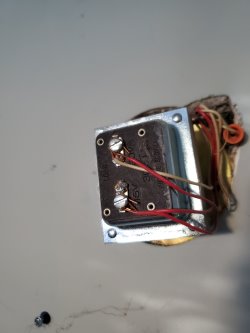| | Published May 11th, 2022
| Fixing old fashioned doorbells
| | | By Jim Hurley |  | | Photo provided |
A common prank for young reprobates is called Doorbell Ditch or Ding Dong Ditch. The principle is to ring a neighbor's doorbell and then run and hide, causing the neighbor inconvenience and consternation at answering the door when no one is there.
 The new camera doorbells have taken the fun out of Doorbell Ditch, because the perpetrator is being video recorded and streamed to the homeowner. Not so fun. These doorbell cameras are beneficial for home security if you are tech-savvy enough to connect it to your handheld device and home wifi. There are hundreds of YouTube videos to help with installing these cameras. I won't cover them here.
The new camera doorbells have taken the fun out of Doorbell Ditch, because the perpetrator is being video recorded and streamed to the homeowner. Not so fun. These doorbell cameras are beneficial for home security if you are tech-savvy enough to connect it to your handheld device and home wifi. There are hundreds of YouTube videos to help with installing these cameras. I won't cover them here.
 I do want to talk about old-fashioned doorbells. When the old doorbell breaks, most people just live with it and go back to knocking. I seldom get a call to come fix a doorbell, but oddly enough, I frequently fix them as part of the "While you're here, could you look at this?" list.
I do want to talk about old-fashioned doorbells. When the old doorbell breaks, most people just live with it and go back to knocking. I seldom get a call to come fix a doorbell, but oddly enough, I frequently fix them as part of the "While you're here, could you look at this?" list.
 Some homes have wireless doorbells with a battery-operated button (transmitter) and battery-operated bell (receiver). Typically, these are installed after the original, hardwired, low voltage bell stopped working. They use radio waves to connect and have trouble broadcasting through stone, brick, or metal walls. They also have limited range and won't work if the bell is too far from the button.
Some homes have wireless doorbells with a battery-operated button (transmitter) and battery-operated bell (receiver). Typically, these are installed after the original, hardwired, low voltage bell stopped working. They use radio waves to connect and have trouble broadcasting through stone, brick, or metal walls. They also have limited range and won't work if the bell is too far from the button.
 But if you like the old-fashioned "ding-dong" and wish to repair the hardwired bell, here is my technique. Remember that your doorbell is a low voltage device, it can create very tiny sparks or give you a slight tingle if you are grounded, (standing barefoot on wet soil), so put on your rubber sole shoes and do this fix carefully when the power is on.
But if you like the old-fashioned "ding-dong" and wish to repair the hardwired bell, here is my technique. Remember that your doorbell is a low voltage device, it can create very tiny sparks or give you a slight tingle if you are grounded, (standing barefoot on wet soil), so put on your rubber sole shoes and do this fix carefully when the power is on.
 Start with the button. Is it hard to push or gets stuck when it is pressed? Time for some Tri-Flow. Spray a tiny bit on the edge of the button and push it a few times. If that doesn't fix the problem, gently take the button off the wall. There are two wires screwed to the back. Take your screwdriver and touch it across the bare wires. If the bell rings, the button is faulty and should be replaced. If the bell does not ring when the wires are crossed, disconnect them from the button and twist them together, closing the circuit, to help continue with your testing.
Start with the button. Is it hard to push or gets stuck when it is pressed? Time for some Tri-Flow. Spray a tiny bit on the edge of the button and push it a few times. If that doesn't fix the problem, gently take the button off the wall. There are two wires screwed to the back. Take your screwdriver and touch it across the bare wires. If the bell rings, the button is faulty and should be replaced. If the bell does not ring when the wires are crossed, disconnect them from the button and twist them together, closing the circuit, to help continue with your testing.
 With the wires connected, go check the bell box. Is it humming? Humming is good news! The humming tells you that the bell's transformer is working, and you have good wiring. The humming means your problem is in the bell box. Go back to the button and disconnect the wires until you finish debugging the bell box.
With the wires connected, go check the bell box. Is it humming? Humming is good news! The humming tells you that the bell's transformer is working, and you have good wiring. The humming means your problem is in the bell box. Go back to the button and disconnect the wires until you finish debugging the bell box.
 If you do not hear humming, you need to find the voltage transformer. The transformer is a lump of metal with small wires attached. Typically it is mounted on a cover plate over an electrical junction box on the wall of your garage, or in a closet, or in the basement if you have one. Scout around and locate it. Now, you need an electrical tester to confirm that it is working. Remember that it is low voltage, (between 12 and 24 volts), and set your tester accordingly. If there is no voltage coming out of the transformer, carefully check inside the junction box to be sure there is power (120 volts) to the transformer. Replace or repair accordingly.
If you do not hear humming, you need to find the voltage transformer. The transformer is a lump of metal with small wires attached. Typically it is mounted on a cover plate over an electrical junction box on the wall of your garage, or in a closet, or in the basement if you have one. Scout around and locate it. Now, you need an electrical tester to confirm that it is working. Remember that it is low voltage, (between 12 and 24 volts), and set your tester accordingly. If there is no voltage coming out of the transformer, carefully check inside the junction box to be sure there is power (120 volts) to the transformer. Replace or repair accordingly.
 Back to that humming at the bell box. Grab your trusty can of Tri-Flow and lightly spray the little piston (ding) or pistons (ding and dong), work it up and down a little and then see if it bounces up to strike the bell plate. Push the bell button (connect the two wires by the door) and see if that worked. If the problem was with the button sticking and the bell was stuck "on" for a few hours, the coils that make the pistons ring are fried. You will need to replace the bell box. The big box stores don't carry much selection. If you want something nice, it might be better to shop online.
Back to that humming at the bell box. Grab your trusty can of Tri-Flow and lightly spray the little piston (ding) or pistons (ding and dong), work it up and down a little and then see if it bounces up to strike the bell plate. Push the bell button (connect the two wires by the door) and see if that worked. If the problem was with the button sticking and the bell was stuck "on" for a few hours, the coils that make the pistons ring are fried. You will need to replace the bell box. The big box stores don't carry much selection. If you want something nice, it might be better to shop online.
 After checking the button, the transformer, and the bell box, your last resort is the wiring. The wire for doorbells is thin (low voltage) and might have been cut or broken accidentally. Use a continuity tester (or ohm meter) to confirm that the wires are not broken. If it is not a complete circuit, it might be easiest to run new wire than to try and trace the old wires. Or call your handyman to come do that for you.
After checking the button, the transformer, and the bell box, your last resort is the wiring. The wire for doorbells is thin (low voltage) and might have been cut or broken accidentally. Use a continuity tester (or ohm meter) to confirm that the wires are not broken. If it is not a complete circuit, it might be easiest to run new wire than to try and trace the old wires. Or call your handyman to come do that for you.
 Hopefully by now you are enjoying the dulcet tones of a working doorbell. Please excuse me as I put on my fastest sneakers and go visit my neighbor.
Hopefully by now you are enjoying the dulcet tones of a working doorbell. Please excuse me as I put on my fastest sneakers and go visit my neighbor. |
 | | Jim Hurley is an independent handyman with over 25 years of experience in residential repairs. Hopefully this free advice is helpful to someone attempting Do-It-Yourself home repairs. The information presented is intended for informational purposes and for use by persons having appropriate technical skill, at their own discretion and risk. | | | | | | | | | | | |




